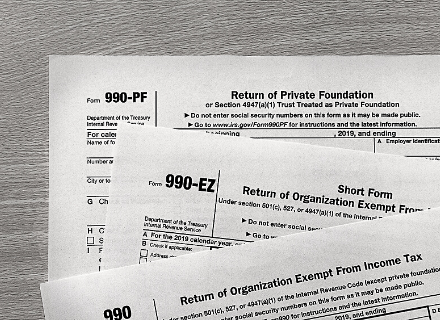Navigating the Form 990 to find funding

If you work at a nonprofit or have thought about starting one, chances are you’re already familiar with the Form 990. All tax-exempt organizations, including foundations, must file some version of Form 990 with the IRS each year to comply with federal regulations. Because of that, they’re chock full of vital information about a nonprofits’ and foundations’ finances and operations.
On the one hand, this is great, knowledge is power! On the other hand, they can be cumbersome and overwhelming to navigate. Here we share some quick facts about the Form 990 to help you quickly access the information you seek.
Do foundations file the same Form 990 as nonprofit organizations?
No, private foundations file Form 990-PF (PF stands for Private Foundation), which is a different version from the Form 990 filed by public charities (organizations that use publicly collected funds to directly support initiatives). The additional fields in the Form 990-PF can be vital tools for grantseekers when researching a foundation’s past giving patterns, and will include the recipients’ names, locations, and grant amounts. Some funders will even briefly describe the purpose of each grant.
Are there differences between the Forms 990 and 990-PF?
Indeed there are. Form 990-PF includes information on:
- A private foundation’s assets
- Financial activities
- Trustees and officers
- Most importantly, a complete list of grants awarded for the specified fiscal year
Form 990 has information on a public charity’s finances and activities which is accurate and open to public scrutiny, including:
- Charity assets
- Total figures for donations and grants received
- Board and top staff members
- Whether the charity makes grants
However, public charities are not required to publicly disclose names and addresses of contributors. You can read more about how to research individual donors here.
Do even small organizations have to file a Form 990?
In short, yes, but it’s pretty simple to do. Public charities with annual gross receipts of less than $50,000 do not have to file the complete Form 990. Instead, they may file the Form 990-N, also called the “e-Postcard.” This short electronic form tells the IRS that the charity is still operating. Only very basic information is required: the organization’s legal name, location, Employer Identification Number (EIN, and the principal officer’s name).
You can search e-Postcard filings using the IRS’s Tax Exempt Organizations Search.
Ok, I understand the differences now. How can I use them to research potential?
990s can be used for a variety of research purposes. For example:
- Contact information. The 990 might be the only reliable go-to resource for contact information if the nonprofit does not have a website—and 90% of them don’t.
- Partners and funders. Search for collaborative partners and funders whose missions align with your own.
- Who’s who. The 990 provides the names of organizations’ board members. You, your board, or staff might know them.
Start your basic research with Candid’s 990 Finder, an easy way to search our database of individual 990 forms of private foundations, public charities, and other nonprofits. To save time and really dig deep, check out subscriptions to Candid’s Foundation Directory. Instead of looking through individual 990s you can surface the information you need in one search, accessing information on over 242,000 U.S. foundations.
Read the full article on Form 990s and how to use them.







Panfil mwanza says:
Quite encouraging